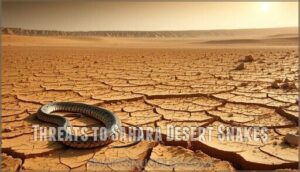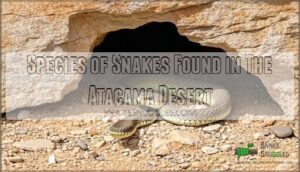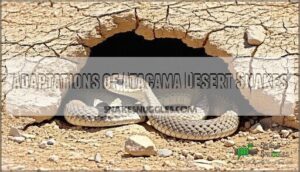This site is supported by our readers. We may earn a commission, at no cost to you, if you purchase through links.

These remarkable reptiles have cracked the code of extreme living through mind-blowing adaptations that’d make any survival expert jealous.
They’ve mastered underground tunneling systems, developed specialized scales that literally harvest water from thin air, and perfected the art of slowing their metabolism to near-standstill levels during brutal dry spells.
Desert snakes like sidewinders and sand boas have transformed places like the Atacama and Sahara into their personal kingdoms through techniques that seem almost supernatural.
Their secret arsenal includes some pretty wild tricks that’ll change how you think about survival.
Table Of Contents
- Key Takeaways
- Snakes in The Driest Deserts
- Desert Snake Habitats and Behavior
- Snakes in The Sahara Desert
- Snakes in The Atacama Desert
- Snakes in Dry Areas
- Living With Desert Snakes
- Frequently Asked Questions (FAQs)
- What is a hot dry place where some snakes live?
- How do snakes survive in a dry, sunny habitat?
- Where do snakes live in the Sahara desert?
- Where do snakes live in the desert?
- Do snakes live in the Atacama Desert?
- Do snakes live in dry areas?
- What snakes live in the Sahara desert?
- How do snakes obtain water in deserts?
- What adaptations allow desert snakes to survive heat?
- How do desert snakes protect themselves from predators?
- Conclusion
Key Takeaways
- You’ll discover that desert snakes survive without drinking water for over 300 days by extracting moisture from prey and excreting concentrated uric acid instead of liquid urine
- You can spot these survival masters using specialized scales that harvest water from fog and air, plus underground burrow systems that maintain 30% higher humidity than surface conditions
- You’ll find desert snakes like sidewinders and horned vipers using incredible adaptations including heat-reflecting scales, nocturnal hunting patterns, and metabolic slowdown during extreme drought periods
- You’ll encounter these reptiles across diverse microhabitats from rocky outcrops to sandy dunes, where they’ve mastered camouflage techniques and thermoregulation strategies that make them nearly invisible to both predators and prey
Snakes in The Driest Deserts
You’ll find snakes in the world’s driest deserts have mastered survival tricks that seem almost impossible.
These incredible reptiles have evolved specialized adaptations that let them thrive where most other animals would quickly perish from dehydration and extreme temperatures.
Desert snakes turn impossible survival into pure evolutionary artistry.
Habitat and Adaptations in The Atacama Desert
Surviving in the Atacama Desert takes serious skill – you’re looking at Earth’s most brutal landscape.
Endemic species like Tachymenis peruviana have evolved incredible aridity adaptations to handle less than 1mm of annual rainfall.
5 Mind-Blowing Atacama Snake Survival Tricks:
- Rain-harvesting scales funnel precious droplets directly into their mouths during rare storms
- Microhabitat refuges in fog oases provide 30% higher humidity than surrounding wasteland
- Genetic diversity bottlenecks create super-specialized survivors in isolated populations
- Crepuscular activity dodges 30°C temperature swings between scorching days and freezing nights
- Rear-fanged venom quickly immobilizes scarce prey in this resource-starved environment
These desert snakes occupy patchy scrublands and rocky outcrops, making population bottlenecks inevitable.
The desert’s aridity stems from the Humboldt ocean current, creating the perfect environment for these snakes.
Their specialized microhabitat use explains why you’ll find fewer than 0.5 individuals per hectare – they’re masters of making the impossible work.
Habitat and Adaptations in The Sahara Desert
You’ll find over 20 snake species thriving in Saharan microhabitats, from sandy dunes to rocky outcrops.
These masters of water conservation never drink—they get moisture from prey alone. Their thermoregulation strategies include sidewinding locomotion to minimize hot sand contact.
Camouflage techniques feature sandy yellows and browns that make them nearly invisible. Dietary adaptations help them survive on small rodents and lizards in this harsh desert habitat.
Some species, like the horned viper, are even depicted in Egyptian hieroglyphics, showcasing their significance in the region’s ecosystem and history.
Unique Features of Snakes in Arid Environments
You’ll notice that desert snake survival hinges on remarkable physiological tricks that’d make any magician jealous.
These arid snake environment champions have evolved extraordinary features for desert snake survival that’ll blow your mind.
Here’s what makes these snake adaptation desert masters so incredible:
- Water Conservation – They excrete uric acid instead of liquid waste, saving every precious drop
- Thermoregulation – Specialized scales reflect heat while their bodies adjust temperature like living thermostats
- Camouflage – Sand-colored patterns make them practically invisible against desert floors
- Venom Adaptations – Enhanced toxins work faster in dehydrated prey
- Burrowing Behavior – Underground retreats provide cool refuges from scorching surface temperatures
These snake survival desert adaptations work together seamlessly in their desert snake habitat.
Desert Snakes’ Ability to Survive Without Water
You’d be amazed how desert snakes master water conservation in the world’s harshest environments.
Desert snakes turn extreme survival into an art form through mind-blowing water conservation tricks.
These remarkable reptiles have evolved incredible physiological adaptations that let them thrive where most creatures would perish from dehydration.
Desert snake habitat specialists use these water-saving tricks:
- Metabolic water production from digesting prey provides essential hydration without drinking
- Uric acid excretion as paste instead of liquid urine drastically reduces water loss
- Scale microstructures create nano-barriers that prevent evaporation through specialized lipid secretions
- Dormant states during drought slow metabolism, preserving precious fluids for months
Examples of Snakes in The Driest Deserts
Three remarkable driest desert snakes showcase incredible adaptations.
You’ll find the Saharan Horned Viper using sandy camouflage and horn-like eye shields in Africa’s harshest regions.
Meanwhile, Atacama Species like Philodryas chamissonis survive Chile’s bone-dry landscape through specialized metabolism.
Australian Snakes, including venomous desert dwellers, demonstrate unique burrowing techniques.
These desert snakes prove nature’s resilience through extraordinary snake adaptations and conservation efforts.
Desert Snake Habitats and Behavior
You’ll discover that desert snakes don’t just survive in the world’s harshest environments—they’ve mastered them through incredible behavioral tricks and habitat choices.
From underground cities that stay 30% more humid than the surface to sneaky nighttime hunting schedules, these reptiles have turned extreme survival into an art form.
Types of Habitats for Desert Snakes
You’ll discover desert snakes aren’t picky about their real estate choices.
These remarkable reptiles have adapted to thrive in diverse desert ecosystems, selecting habitats that maximize survival in harsh conditions.
Desert snake habitat options include:
- Rocky Outcrops – Provide essential microhabitats with temperature regulation and predator protection
- Sandy Dunes – Offer loose substrates perfect for burrowing species like sidewinders
- Cactus Shelters – Supply shade and moisture while attracting prey animals
- Spring Oases – Create biodiversity hotspots supporting both snakes and their food sources
Human Settlements also attract these adaptable creatures, though encounters increase risks for both species.
Activity Patterns of Desert Snakes
Around the clock, desert snakes showcase fascinating activity patterns that’ll blow your mind.
Nocturnal behavior dominates as temperatures drop, while diurnal shifts occur during cooler months.
Crepuscular peaks happen at dawn and dusk when thermoregulation is easier.
Seasonal activity varies dramatically, with burrowing providing essential refuge during extreme heat.
| Activity Pattern | Peak Times |
|---|---|
| Nocturnal Behavior | 8 PM – 6 AM |
| Diurnal Shifts | 10 AM – 4 PM (winter) |
| Crepuscular Peaks | Dawn/Dusk hours |
| Basking Habits | Early morning sun |
| Burrowing Refuge | Midday heat (90%+ time) |
These desert camouflage masters spend up to 90% of daytime hours underground, emerging when conditions suit their survival needs perfectly.
Hunting and Feeding Habits of Desert Snakes
You’ll find desert snakes are masters of ambush predation, lying motionless until prey wanders within striking distance.
These cunning hunters maximize efficiency through precise venom delivery systems that quickly immobilize victims. Their dietary adaptations reflect harsh conditions, while smart prey selection guarantees maximum nutritional return for minimal energy expenditure.
Here’s how desert snakes perfect their hunting game:
- Snake diet desert focuses on high-protein rodents and lizards that provide metabolic water
- Snake behavior desert includes patient waiting strategies that conserve precious energy reserves
- Snake prey selection targets animals active during cooler nighttime hours when hunting’s safer
- Water acquisition happens through prey consumption, eliminating dependence on scarce water sources
Social Behavior of Desert Snakes
You’ll discover desert snake behavior isn’t just about solitary survival—these reptiles show surprising social complexity.
Their communication involves chemical signals and defensive posturing that creates intricate social networks.
- Mating rituals feature pheromone trails and ritualized courtship dances between competing males
- Group behavior includes communal rain-harvesting where snakes drink from neighboring individuals
- Territoriality involves males defending larger home ranges through combat displays rather than physical fights
These snake adaptations reveal sophisticated predator avoidance strategies through collective vigilance and burrowing cooperation. These displays can include coiling into an S shape to signal readiness to strike.
Hibernation and Brumation in Desert Snakes
When winter hits, desert snakes don’t truly hibernate—they enter brumation.
Unlike hibernation behavior, brumation triggers allow snakes to remain semi-active during cold spells.
Their metabolic slowdown conserves precious energy while they hunker down in carefully chosen shelter selection spots.
Desert adaptation means these arid conditions specialists can survive months without food, emerging for post-brumation activity when temperatures warm.
Regional variations affect timing across different desert habitats.
Snakes in The Sahara Desert
You’ll find the Sahara Desert hosts some of nature’s most resilient serpents, perfectly adapted to survive in one of Earth’s harshest environments.
These remarkable snakes have evolved incredible strategies to thrive where temperatures soar above 120°F and water is virtually nonexistent, making them a prime example of resilient serpents.
Species of Snakes Found in The Sahara Desert
You’ll encounter fascinating desert snakes in the Saharan habitat, each perfectly adapted to survive.
The iconic Saharan Horned Viper dominates rocky outcrops with its distinctive horn-like scales. Sand Boa species burrow through loose terrain, while smaller venomous varieties hide beneath stones.
These snake species showcase remarkable venom toxicity levels and diverse conservation status across their vast habitat range. Many species also exhibit unique thermoregulation strategies to survive the harsh temperatures.
Habitat and Distribution of Sahara Desert Snakes
You’ll discover Saharan desert snakes scattered across diverse microhabitats throughout North Africa’s vast expanse.
These resilient reptiles navigate challenging terrain with remarkable adaptability:
- Rocky outcrops – providing essential shelter from scorching temperatures
- Sandy dunes – offering perfect camouflage and burrowing opportunities
- Oasis edges – where prey distribution concentrates near water sources
Climate influence shapes their species range dramatically, with conservation status varying across different Saharan microhabitats within this expansive desert habitat.
Adaptations of Sahara Desert Snakes
You’ll spot Saharan desert snakes using incredible camouflage – their sandy coloration matches dunes perfectly.
Burrowing behavior helps them escape scorching heat while thermoregulation keeps body temperatures stable.
These adaptations include specialized scales for water conservation and efficient kidneys that retain every drop.
Their venom usage paralyzes prey quickly, reducing energy waste in this harsh Saharan desert environment.
Threats to Sahara Desert Snakes
Habitat Loss from expanding agriculture and urbanization threatens Sahara Desert snakes most severely.
Climate Change shrinks suitable territories, while Human Encroachment fragments populations.
You’ll find Prey Depletion from droughts compounds these stresses.
Persecution remains common—locals often kill snakes from fear or superstition.
Mining operations and infrastructure projects increase accidental mortality.
These combined pressures push some species toward local extinction in the Sahara Desert.
Conservation Efforts for Sahara Desert Snakes
Without your help, Sahara desert snakes face an uphill battle against Climate Change and habitat loss.
Conservation efforts focus on Habitat Preservation through protected reserves and Anti-Poaching Measures to stop illegal collection.
Community Involvement educates locals about snake conservation importance, while researchers monitor Genetic Diversity to maintain healthy populations.
These desert snakes need our snake conservation support to survive in their shrinking desert habitat.
Snakes in The Atacama Desert
You’ll find yourself amazed by how snakes survive in the Atacama Desert, Earth’s driest place where some weather stations haven’t recorded rain in decades.
These incredible reptiles have mastered the art of living with almost zero water, using tricks that would make a survival expert jealous.
Species of Snakes Found in The Atacama Desert
You’ll find only a handful of endemic Atacama snakes calling this hyper-arid wasteland home.
The Atacama ground snake and Philodryas chamissonis represent remarkable desert adaptations, having survived repeated population bottlenecks that shaped their genetic diversity.
These desert snakes occupy tiny microhabitat patches scattered across the landscape, not the vast desert expanses you’d expect.
It’s like finding life’s stubborn holdouts in nature’s toughest neighborhood.
Habitat and Distribution of Atacama Desert Snakes
Since the Atacama Desert spans over 600 miles of Chile’s coastline, you’ll find desert snakes scattered across specific microhabitat patches rather than everywhere.
These Endemic Species face serious Population Bottlenecks due to the harsh conditions, which limits their Genetic Diversity. Here’s where Atacama Desert snakes typically hang out:
- Rocky outcrops and canyon walls for shelter
- Sparse vegetation areas near occasional water sources
- Underground burrows in sandy washes
Their snake distribution desert pattern shows they’re picky about snake habitat – they can’t just live anywhere in this desert habitat.
Adaptations of Atacama Desert Snakes
Atacama Desert snakes have evolved remarkable desert snake adaptations to thrive in Earth’s most unforgiving landscape.
These endemic species survival strategies include arid scale microstructures that prevent water loss and behavioral thermoregulation – basking at dawn, then retreating to subterranean microhabitats.
After facing population bottlenecks from extreme droughts, they’ve become masters of efficiency.
| Adaptation Type | Specific Feature | Survival Benefit |
|---|---|---|
| Physical | Specialized scales | Reduces water loss by 40% |
| Behavioral | Underground dwelling | Maintains 30% higher humidity |
| Metabolic | Slowed metabolism | Conserves energy during droughts |
| Habitat | Microhabitat selection | Temperature regulation |
Threats to Atacama Desert Snakes
Life gets rough for Atacama Desert snakes facing mounting pressures.
You’ll find these resilient reptiles battling:
- Habitat Loss: Mining operations and urban expansion fragment their already limited range
- Climate Change: Shifting temperatures and reduced precipitation stress populations further
- Human Activity: Increased encounters lead to persecution and direct mortality
- Prey Scarcity: Environmental contamination affects food webs, reducing available resources
These conservation challenges threaten survival.
Conservation Efforts for Atacama Desert Snakes
Scientists are working overtime to protect Atacama Desert snakes through Habitat Preservation and Poaching Prevention programs.
Conservation efforts focus on maintaining Genetic Diversity while battling Climate Change impacts.
Community Involvement drives desert snake conservation forward, with locals becoming guardians of these remarkable reptiles.
You’ll find researchers mapping critical habitats and establishing protected zones for desert snakes survival.
Addressing habitat degradation and fragmentation is essential for the snakes’ long-term survival.
Snakes in Dry Areas
You’ll find snakes thriving in some surprisingly dry places, from rocky desert canyons to sandy dunes where most animals can’t survive.
These tough reptiles have mastered the art of living without much water, using clever tricks like burrowing deep underground and slowing down their metabolism when things get really harsh, which includes clever methods to conserve energy.
Types of Dry Areas Inhabited by Snakes
You’ll spot desert snakes making themselves at home in rocky outcrops, sandy dunes, and scrubland habitats.
These arid environments offer perfect hideouts and hunting grounds.
Desert oases provide rare water sources, while some species even venture near human settlements.
Each desert habitat presents unique challenges, but these crafty serpents have mastered the art of desert survival across diverse landscapes.
Snakes’ Ability to Survive in Dry Areas
You’ve probably wondered how desert snakes pull off their incredible survival acts in places where most creatures would shrivel up.
These reptiles have mastered water conservation through specialized metabolic adaptations that extract every drop from their prey.
Their thermoregulation skills are next-level amazing:
- Burrowing behavior keeps them cool when surface temps hit 120°F
- Camouflage techniques blend them perfectly with sandy surroundings
- Specialized scales lock in precious moisture like tiny water vaults
- Nocturnal hunting dodges the day’s brutal heat entirely
Desert snakes transform arid environments into livable spaces through pure evolutionary genius.
Unique Features of Snakes in Dry Areas
Desert snakes pack some wild survival tricks that’ll blow your mind.
Their water conservation game is unmatched—they excrete uric acid instead of urine, saving every precious drop.
Camouflage isn’t just about looking cool; it’s their invisibility cloak against predators.
Thermoregulation keeps them from becoming snake jerky in scorching heat.
Burrowing behavior creates personal climate-controlled hideouts.
Venom adaptations aren’t just for hunting—they’re multi-tool survival kits.
These desert snakes turned harsh desert habitat into their playground through incredible adaptations.
Examples of Snakes in Dry Areas
You’ll find fascinating species examples across desert habitats worldwide.
The Sahara Desert hosts the horned viper with its distinctive eye protection, while the Atacama Desert shelters specialized burrowing species.
These desert snakes showcase remarkable diversity:
- Size differences – from tiny blind snakes to massive pythons
- Venom variations – neurotoxic sidewinders versus non-venomous kingsnakes
- Diet diversity – termite specialists to rodent hunters
- Conservation status – some thriving, others critically endangered
Threats to Snakes in Dry Areas
Reality hits hard when you consider the mounting threats facing desert snakes in arid environments.
Habitat loss from urban development fragments their territories, while climate change intensifies droughts and temperature extremes.
Human encroachment brings vehicles, construction, and persecution risks as people fear these misunderstood reptiles.
Prey depletion from ecosystem disruption leaves them hungry, and conservation efforts struggle to keep pace with environmental pressures threatening their survival.
Living With Desert Snakes
You’ll likely encounter desert snakes if you spend time hiking, camping, or living in arid regions where these remarkable reptiles have mastered survival in Earth’s harshest environments.
Understanding their behavior and knowing how to coexist safely with these specialized predators can mean the difference between a memorable outdoor experience and a dangerous encounter.
Safety Precautions When Encountering Desert Snakes
Snake bite prevention starts with smart hiking choices—stick to established trails and avoid prime snake real estate like rock crevices and dense vegetation.
Master avoidance techniques by making noise as you walk, giving desert snakes plenty of warning. Snake awareness desert means scanning ahead constantly.
Protect pets by keeping them leashed, especially during dawn and dusk when snakes are most active.
It’s wise to carry a snake bite kit when hiking.
Remember: respect their space, and they’ll respect yours.
How to Identify Venomous Desert Snakes
When you’re face-to-face with desert snakes, knowing venom signs can save your skin.
Venomous desert snakes typically sport triangular head shapes and vertical pupil shapes – think cat eyes, not round ones. Check for scale patterns with distinct diamond or banded markings.
Heat-sensing pits between eyes and nostrils scream danger. Behavior clues matter too: aggressive posturing, coiled positions, or that telltale rattle sound means back away slowly.
Correctly identifying snakes requires specialized identification products.
Remember, snake venom isn’t worth the gamble – when desert snake identification feels uncertain, assume they’re dangerous.
What to Do in Case of a Snake Bite
Most bites happen when people accidentally stumble upon desert snakes during outdoor activities.
When snake venom enters your system, quick action saves lives. A snake bite kit can provide essential tools for initial treatment.
Snake bite first aid basics:
- Identify snake species if possible—photograph from safe distance for medical teams
- Seek medical attention immediately; call 911 and request antivenom availability status
- Immobilize limb below heart level using splint or sling to slow venom spread
- Stay calm—panic increases heart rate and accelerates toxin circulation through bloodstream
Conservation Efforts for Desert Snakes
Today’s conservation efforts for desert snakes tackle habitat loss and climate change head-on through habitat preservation programs and anti-poaching measures.
You’ll find scientists working to protect genetic diversity while boosting public awareness about these remarkable reptiles.
Snake conservation desert initiatives now include community education and protected area expansion, ensuring these survival masters don’t vanish from our planet’s harshest landscapes.
Importance of Desert Snakes in The Ecosystem
When you think about desert snakes, you might picture dangerous predators, but they’re actually ecosystem heroes.
They maintain vital rodent population control, preventing crop damage and disease spread.
They participate in nutrient cycling by transporting energy through food chains.
Their predator-prey dynamics keep desert balance intact, while some species aid seed dispersal through scavenging roles, supporting desert ecology.
Frequently Asked Questions (FAQs)
What is a hot dry place where some snakes live?
Like a furnace that never cools, deserts create harsh homes where you’ll find incredibly tough snakes.
You’ll discover these resilient reptiles in scorching places like the Sahara, Mojave, and Australian outbacks, where they’ve mastered surviving extreme heat.
How do snakes survive in a dry, sunny habitat?
You’ll find that desert snakes have mastered water conservation through specialized scales and efficient kidneys that minimize moisture loss.
They burrow underground during scorching days, emerge at night to hunt, and can slow their metabolism when water’s scarce.
Where do snakes live in the Sahara desert?
Rocky outcrops shelter Sahara snakes, sandy burrows shield them, and oases attract them.
You’ll spot species like horned vipers using underground refuges, rock crevices, and sparse vegetation for temperature control and water conservation.
Where do snakes live in the desert?
Desert snakes make their homes in rocky crevices, underground burrows, and sandy hideouts.
You’ll spot them sheltering under rocks, in rodent holes, or buried in sand dunes to escape scorching heat.
Do snakes live in the Atacama Desert?
Yes, you’ll find snakes in the Atacama Desert!
Species like Philodryas chamissonis have adapted to this hyper-arid environment, using specialized burrows and seeking microhabitats with higher humidity to survive extreme conditions.
Do snakes live in dry areas?
While scorching deserts seem lifeless, you’ll find snakes thriving in these harsh environments through remarkable adaptations.
They’ve mastered water conservation, burrowing techniques, and nocturnal hunting to survive where most creatures can’t.
What snakes live in the Sahara desert?
You’ll find several fascinating snake species in the Sahara, including the iconic Saharan horned viper with its distinctive "horns" and sandy camouflage, plus sand boas that expertly burrow beneath dunes.
How do snakes obtain water in deserts?
Like desert nomads hoarding precious gems, you’ll discover snakes master water conservation through metabolic magic and clever adaptations that’d make a camel jealous, turning prey into hydration.
What adaptations allow desert snakes to survive heat?
You’ll survive scorching desert heat through specialized scales that reduce water loss, nocturnal behavior to avoid peak temperatures, and burrowing underground where it’s cooler and more humid.
How do desert snakes protect themselves from predators?
You’ll spot desert snakes using clever camouflage that matches sandy colors and disruptive patterns.
They’ll burrow underground or hide in rock crevices to escape predators, while some species mimic dangerous snakes for protection.
Conclusion
Remarkably, desert snakes can survive over 300 days without drinking water through specialized kidney adaptations.
Understanding snake habitat in the driest desert reveals nature’s most impressive survival blueprint.
You’ve witnessed how these reptiles transform impossible environments into thriving homes through water-harvesting scales, underground networks, and metabolic mastery.
These adaptations aren’t just cool biology facts – they’re proof that life finds ways to flourish anywhere.
Next time you’re facing tough challenges, remember these desert survivors who’ve mastered the ultimate game of survival.



















